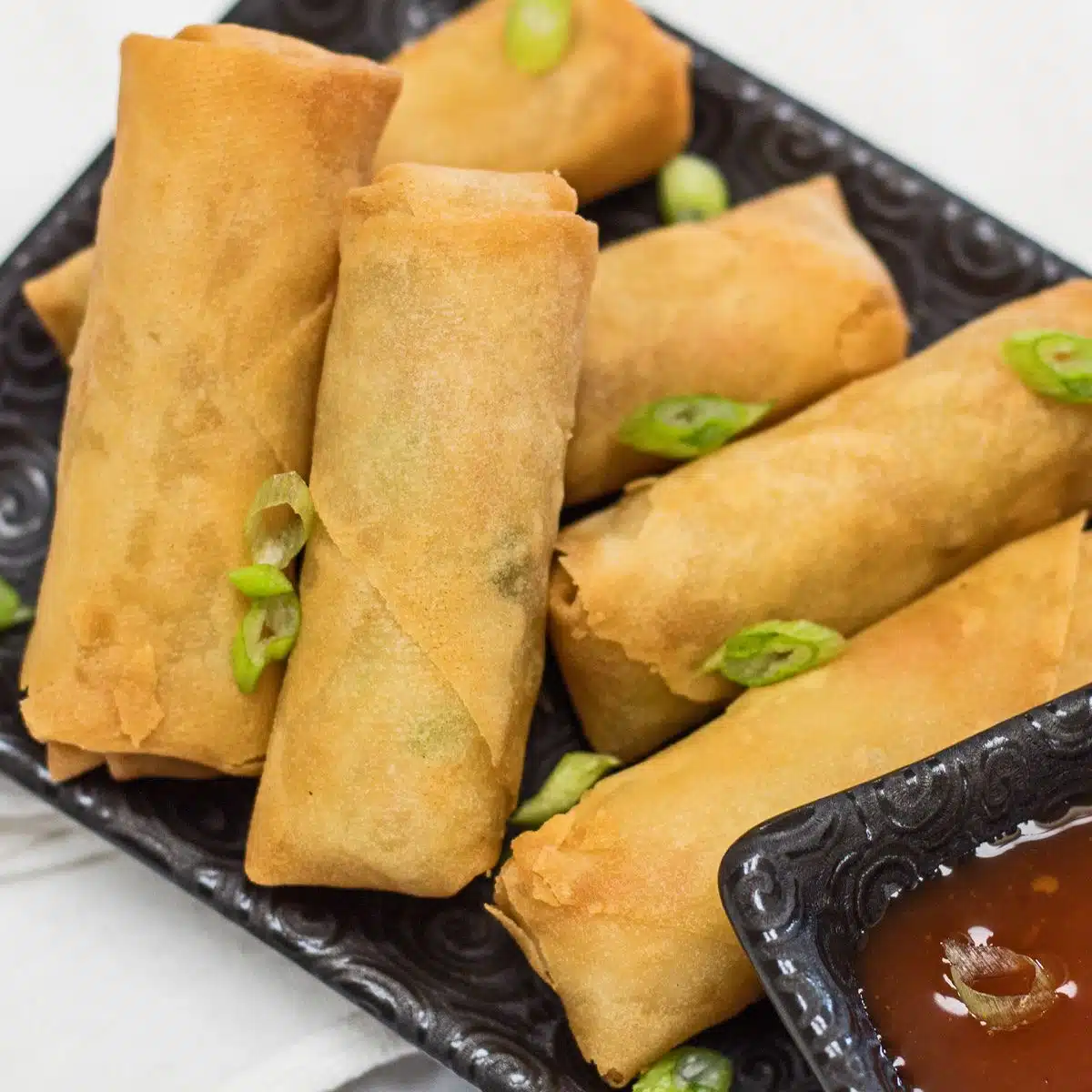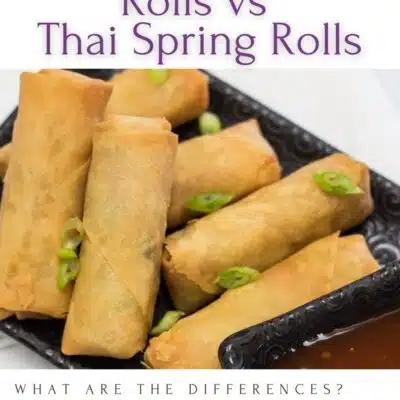Vietnamese spring rolls vs Thai spring rolls: All of the differences and similarities between these two dishes. From preparation to ingredients and everything in between, here's what you need to know. Which one do you want to make first?
For more helpful comparisons, take a look at my posts on Canadian lobster vs Maine lobster, quiche vs frittata, or yams vs sweet potatoes.

Jump to:
Both Vietnamese and Thai spring rolls are popular Southeast Asian dishes. They're usually eaten as appetizers as well as snacks. They definitely have some things in common, but also have differences that make each dish special.
Today we are going to cover everything you need to know! Get ready to learn about all the differences and similarities.
What Are Vietnamese Spring Rolls
Vietnamese spring rolls, also known as Gỏi cuốn or chả giò, are made with a rice paper wrapper that is packed with filling. This filling includes things such as vermicelli noodles, shrimp or pork, lettuce, mint, and bean sprouts. Of course, there are other variations that can include tofu, chicken, or fish.
After wrapping the filling tightly in the rice paper, it is then dipped in a sweet and tangy sauce. This sauce is with fish sauce, lime juice, garlic, chili, and sugar.
Vietnamese spring rolls are known for their light and fresh flavors, and the dipping sauce provides a savory and slightly sweet contrast to the fresh ingredients.
Two Versions Of Vietnamese Spring Rolls
Vietnamese spring rolls can actually come in two different forms. Fresh spring rolls (gỏi cuốn) and the fried version (chả giò). The fillings can be the same or different, with the only true variation being whether or not they were fried.
What Are Thai Spring Rolls
Thai spring rolls, also known as Poh Pia Tod, are made with a deep-fried pastry-style wrapper that is filled with a tasty combination of vegetables and meat. It shares some similarities with the fried version of Vietnamese spring rolls as well as Chinese fried spring rolls.
They usually include bean sprouts, carrots, cabbage, mushrooms, and sometimes shrimp or chicken. The filling can be seasoned with soy sauce, garlic, and other spices before being rolled up.
They are often served with a sweet and sour dipping sauce made with tamarind, palm sugar, fish sauce, and chili.
Differences Between These Rolls
While these are 2 types of spring rolls, they definitely have some differences.
- Wrapper. Vietnamese spring rolls use a rice paper wrapper. On the other hand, Thai spring rolls use a wrapper that is similar to a thin pastry.
- Cooking Method. Vietnamese spring rolls can be fresh or fried and Thai spring rolls are typically fried. *Occasionally, you will see fresh Thai spring rolls, but it is not as common.
- Filling. The Vietnamese version usually has fresh veggies and herbs as well as cooked meat. The Thai variety is more focused on the cooked meats and vegetables.
- Flavor. Vietnamese spring rolls tend to taste lighter and fresh, while Thai spring rolls are savory and crispy.
- Dipping Sauces. The sauce typically served with Vietnamese spring rolls is sweet and tangy, while the Thai sauce is sweet and sour.
Similarities Between Vietnamese & Thai Spring Rolls
Of course, these two dishes share a lot of similarities. They have similar cultural influences as well as traditions.
- Rolling Technique. Both Vietnamese and Thai spring rolls involve a technique of rolling a variety of ingredients in a thin wrapper.
- Ingredients. The ingredients are pretty similar between the two. You'll usually find vegetables as well as protein.
- Dipping Sauces. Both are typically served with a dipping sauce. Of course, the ingredients of the sauces can vary based on regional flavors.
- Serving Style. Both are often served as appetizers or snacks and are popular street food items.
Table 1. Comparing Vietnamese & Thai Spring Rolls
| Thai Spring Rolls | Vietnamese Spring Rolls | |
|---|---|---|
| Wrapper | Thin pastry wrapper | Rice paper wrapper |
| Cooking Method | Fried | Fresh or fried |
| Filling | Cooked meats & vegetables | Fresh vegetables, herbs, and cooked meat |
| Dipping Sauce | Sweet and sour | Sweet and tangy |
| Serving Style | Appetizer, snacks | Appetizer, snacks |
| Flavor | Savory and crispy | Light and fresh |
Which One Is Better
Both Vietnamese and Thai spring rolls are delicious appetizers enjoyed around the world. While they definitely have some similarities (like being wrapped), they do have some big differences, too!
Both dishes will certainly satisfy any cravings you may have for Southeast Asian cuisine. If you're looking for light and fresh, choose the Vietnamese variety. Meanwhile, the Thai version has a taste that is more savory and fried.
>>>See All Of My Tasty Recipes Here!<<<
Now that you know the similarities between Vietnamese and Thai spring rolls, which one do you prefer? Leave a comment down below and let me know your thoughts!
Do you love a recipe you tried? Please leave a 5-star 🌟rating in the recipe card below and/or a review in the comments section further down the page.
Stay in touch with me through social media @ Pinterest, Facebook, Instagram, or Twitter! Subscribe to the newsletter today (no spam, I promise)! Don't forget to tag me when you try one of my recipes!
📖 Recipe Card
Vietnamese Spring Rolls vs Thai Spring Rolls: Thai Spring Rolls (+More Info!)
Ingredients
- 20 large spring roll wrappers
- oil (for deep frying)
Filling
- ¾ cup bean thread noodles (glass noodles or cellophane noodles)
- 3 cloves garlic
- 1 teaspoon black peppercorns
- 2 coriander roots (chopped)
- 1 tablespoon olive oil (extra virgin)
- 7 oz pork (minced)
- 1 cup carrot (grated)
- 2 cups cabbage (finely sliced)
- 2 tablespoon fish sauce
For Rolling
- 3 tablespoon all-purpose flour
- 3 tablespoon water
(Note: 2x or 3x only changes the ingredient list)
Instructions
Prepare the Filling
- Soak ¾ cup bean thread noodles in warm water for 5 minutes to soften them. Then, drain off the water and use scissors to cut them into shorter pieces.
- Using a mortar and pestle to smash the 3 cloves garlic, 1 teaspoon black peppercorns, and 2 coriander roots to a fine paste.
- In a large skillet, heat 1 tablespoon olive oil over medium heat.
- Once hot, add the garlic mixture and cook for about one minute. Then, add 7 oz pork and cook until just cooked through.
- In the same skillet, add the softened noodles, 1 cup carrot, 2 cups cabbage, and 2 tablespoon fish sauce. Cook for about 3 minutes or until vegetables are soft. Taste and add more fish sauce if needed. Set aside to cool.
Roll
- In a small mixing bowl, whisk together 3 tablespoon all-purpose flour and 3 tablespoon water to form a thick paste.
- Lay out one of your 20 large spring roll wrappers and place a heaping tablespoon of the filling into the middle.
- Roll the spring roll by folding it like an envelope and then seal it using a small amount of the water and flour mixture. Repeat with the remaining wrappers.
Fry
- Heat enough oil in a saucepan so that you can deep fry your spring rolls.
- Once the oil is hot, fry your spring rolls (working in small batches) for about 3-4 minutes, or until golden in color.
- Remove the cooked spring rolls to a wire cooling rack over a paper towel to drain off the excess oil.
- Serve immediately with your preferred dipping sauce.
Notes
- If you aren't a fan of pork, you can swap it out for chicken, finely minced shrimp, tofu, or even a mixture of both shrimp and chicken.
- Give your filling some time to completely cool down before you start the rolling process. If you use it while it is still too warm, it will make the spring roll wrappers much harder to work with.
- When rolling your spring rolls, you'll want to wrap them as tightly as possible. Any excess air pockets could soak up too much oil and could alter the flavor.
- To store: You can store your spring rolls, once cooled, in a sealed container in the fridge for 3-4 days.
- To reheat: Reheat your spring rolls in the oven on a baking sheet at 350°F (175°C/Gas Mark 4). You could also use your air fryer.
- To make ahead: Completely prepare and wrap your spring rolls, but skip frying them. Instead, you can freeze them on a baking sheet until solid and then transfer them to a food storage bag. They can be frozen for 1-2 months. Deep fry when you are ready.
Nutrition
Originally published August 12, 2023



Comments
No Comments